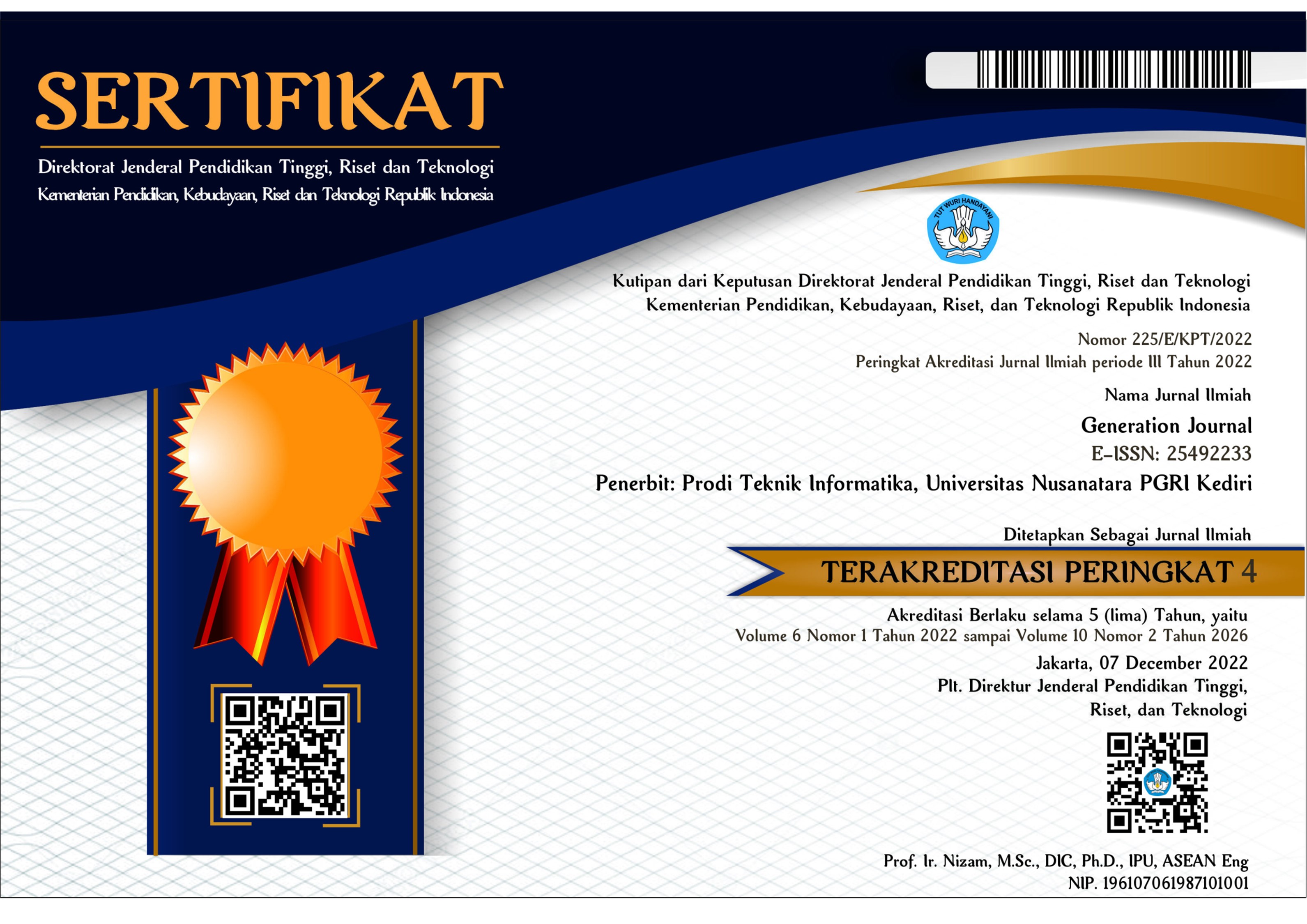Analisis Klasifikasi Penyakit Multiple Sclerosis Menggunakan Algoritma Logistic Regression dan SVM
DOI:
https://doi.org/10.29407/gj.v8i1.20646Keywords:
Data Mining, Multiple Sclerosis, Python, Logistic Regression, SVMAbstract
Health is the most important aspect to support daily activities. Of course, by having a healthy body, everyone can carry out various activities comfortably and calmly. Every individual certainly has a strong instinct to live a healthy life and be free from disease, one of which is by increasing the body's immunity. Multiple sclerosis (multiple sclerosis/MS) is a neurodegenerative autoimmune disease that affects the central nervous system. The affliction of MS is characterized by chronic inflammation, demyelination, gliosis, and neuronal death. The symptoms faced by MS patients are unpredictable, so there is a need for a classification related to the disease. Therefore, a classification study was carried out using the logistic regression algorithm and SVM. The method used in this research is a literature study with the Python programming language. The results of this study indicate that the SVM algorithm has a high accuracy rate of 88.33% of the logistic regression algorithm. So it can be concluded from this study that the SVM method has good performance for processing multiple sclerosis datasets.
References
A. Raksanagara and A. Raksanagara, “Perilaku Hidup Bersih Dan Sehat Sebagai Determinan Kesehatan Yang Penting Pada Tatanan Rumah Tangga Di Kota Bandung,” J. Sist. Kesehat., vol. 1, no. 1, pp. 30–34, 2016, doi: 10.24198/jsk.v1i1.10340.
R. A. Rosdiana, Destya Sabrina Pujian, H. Angelia, N. Zulpa, Elhapidi, and F. Rachmatullah, “Analisis Gejala Multiple Sclerosis Sejak Dini Dan Penangannya,” vol. 5, pp. 1–23, 2023.
R. Estiasari, N. Devianca, K. Maharani, and D. Imran, “Multipel Sklerosis Progresif Sekunder, Gejala Klinis, Diagnosis, Dan Tata Laksana,” Maj. Kedokt. Neurosains Perhimpun. Dr. Spes. Saraf Indones., vol. 37, no. 3, 2020, doi: 10.52386/neurona.v37i3.166.
C. J. Suryo, “Sklerosis Multipel: Diagnosis dan Tatalaksana,” Cermin Dunia Kedokt., vol. 48, no. 8, pp. 296–303, 2021, doi: 10.55175/cdk.v48i8.111.
dr. Rashmeeta; Dr. dr. Stevent Sumantri; DAA; Sp.PD; K-AI, “Mengenali Multiple Sclerosis,” 2022. https://dokterimun.id/2022/07/23/mengenali-multiple-sclerosis/ (accessed Jun. 26, 2023).
S. Galikano, “Kisah Kanya Puspokusumo Berdamai dengan Multipel Sklerosis,” 2015. https://www.cnnindonesia.com/gaya-hidup/20151228095923-255-100666/kisah-kanya-puspokusumo-berdamai-dengan-multipel-sklerosis (accessed Jun. 27, 2023).
M. V. Babo and I. A. Dwiatmoko, “Analisis Faktor-Faktor Yang Berhubungan Dengan Terjangkitnya Penyakit Malaria Dengan Menggunakan Model Regresi Logistik Binimial,” Asimtot J. Kependidikan Mat., vol. 2, no. 1, pp. 27–37, 2020, doi: 10.30822/asimtot.v2i1.498.
H. Amalia, “Perbandingan Metode Data Mining Svm Dan Nn Untuk Klasifikasi Penyakit Ginjal Kronis,” Maret, vol. 14, no. 1, p. 1, 2018, [Online]. Available: www.bsi.ac.id
N. J. A. Kisma and C. R. S. Ajeng, “Analisis Aplikasi Di Playstore Berdasarkan Rating Dan Type Menggunakan Naive Bayes Dan Logistik Regresi,” vol. 10, no. 2, pp. 174–184, 2023.
M. National Institute of Neurology and Neurosurgery (NINN) in Mexico City, “Multiple Sclerosis Disease,” 2010. https://www.kaggle.com/datasets/desalegngeb/conversion-predictors-of-cis-to-multiple-sclerosis (accessed Jun. 30, 2023).
N. A. N. Roosyidah and P. K. Supriyatna, “Pemodelan Regresi Logistik untuk Diagnosis Dini Infeksi Covid-19 di Indonesia,” Jambura J. Math., vol. 4, no. 2, pp. 232–246, 2022, doi: 10.34312/jjom.v4i2.12653.
K. W. Patunduk and A. Pratiwi, “Pemodelan Pasien Covid-19 Di Kota Palopo Dengan Regresi Logistik ( Studi Perbandingan Regresi Logistik dan Analisis Survival ),” J. Penelit. Mat. dan Pendidik. Mat., vol. 5, pp. 260–269, 2022.
L. I. Permatasari, M. . Astri Novianty, S.T, and M. Pm. Dr. Tito Waluyo Purboyo, S.Si, S.T, “Heart Disorder Detection Based on Computerized Iridology Using SVM Classification Method,” e- Proceeding Eng., vol. 3, no. 1, pp. 786–792, 2016.
H. Syah and A. Witanti, “Analisis Sentimen Masyarakat Terhadap Vaksinasi Covid-19 Pada Media Sosial Twitter Menggunakan Algoritma Support Vector Machine (Svm),” J. Sist. Inf. dan Inform., vol. 5, no. 1, pp. 59–67, 2022, doi: 10.47080/simika.v5i1.1411.
A. Amrin and H. Saiyar, “Aplikasi Diagnosa Penyakit Tuberculosis Menggunakan Algoritma Data Mining,” J. Ris. Komput., vol. 5, no. 5, pp. 498–502, 2018, [Online]. Available: http://ejournal.bsi.ac.id/ejurnal/index.php/paradigma
D. C. rini Novitasari, M. F. Rozi, and R. Veriani, “Klasifikasi Kelainan Pada Jantung Melalui Citra Iris Mata Menggunakan Fuzzy C-Means Sebagai Pengambil Fitur Iris Dan Klasifikasi Menggunakan Support Vector Machine,” INTEGER J. Inf. Technol., vol. 4, no. 1, pp. 1–10, 2019, doi: 10.31284/j.integer.2019.v4i1.489.
Downloads
Published
Issue
Section
License
Authors who publish with this journal agree to the following terms:
- Copyright on any article is retained by the author(s).
- The author grants the journal, the right of first publication with the work simultaneously licensed under a Creative Commons Attribution License that allows others to share the work with an acknowledgment of the work’s authorship and initial publication in this journal.
- Authors are able to enter into separate, additional contractual arrangements for the non-exclusive distribution of the journal’s published version of the work (e.g., post it to an institutional repository or publish it in a book), with an acknowledgment of its initial publication in this journal.
- Authors are permitted and encouraged to post their work online (e.g., in institutional repositories or on their website) prior to and during the submission process, as it can lead to productive exchanges, as well as earlier and greater citation of published work.
- The article and any associated published material is distributed under the Creative Commons Attribution-ShareAlike 4.0 International License













